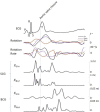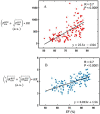Assessment of left ventricular twist by 3D ballistocardiography and seismocardiography compared with 2D STI echocardiography in a context of enhanced inotropism in healthy subjects
- PMID: 33436841
- PMCID: PMC7804966
- DOI: 10.1038/s41598-020-79933-4
Assessment of left ventricular twist by 3D ballistocardiography and seismocardiography compared with 2D STI echocardiography in a context of enhanced inotropism in healthy subjects
Abstract
Ballistocardiography (BCG) and Seismocardiography (SCG) assess the vibrations produced by cardiac contraction and blood flow, respectively, by means of micro-accelerometers and micro-gyroscopes. From the BCG and SCG signals, maximal velocities (VMax), integral of kinetic energy (iK), and maximal power (PMax) can be computed as scalar parameters, both in linear and rotational dimensions. Standard echocardiography and 2-dimensional speckle tracking imaging echocardiography were performed on 34 healthy volunteers who were infused with increasing doses of dobutamine (5-10-20 μg/kg/min). Linear VMax of BCG predicts the rates of left ventricular (LV) twisting and untwisting (both p < 0.0001). The linear PMax of both SCG and BCG and the linear iK of BCG are the best predictors of the LV ejection fraction (LVEF) (p < 0.0001). This result is further confirmed by mathematical models combining the metrics from SCG and BCG signals with heart rate, in which both linear PMax and iK strongly correlate with LVEF (R = 0.7, p < 0.0001). In this setting of enhanced inotropism, the linear VMax of BCG, rather than the VMax of SCG, is the metric which best explains the LV twist mechanics, in particular the rates of twisting and untwisting. PMax and iK metrics are strongly associated with the LVEF and account for 50% of the variance of the LVEF.
Conflict of interest statement
P-F. Migeotte, D. Gorlier and A. Hossein declare having direct ownership of shares in Healthcare Company. S. Morra, J. Rabineau, J. Racape, P. van de Borne do not declare any conflict of interest.
Figures


Similar articles
-
Influence of sympathetic activation on myocardial contractility measured with ballistocardiography and seismocardiography during sustained end-expiratory apnea.Am J Physiol Regul Integr Comp Physiol. 2020 Oct 1;319(4):R497-R506. doi: 10.1152/ajpregu.00142.2020. Epub 2020 Sep 2. Am J Physiol Regul Integr Comp Physiol. 2020. PMID: 32877240
-
The kinocardiograph for assessment of changes in haemodynamic load in patients with chronic heart failure with reduced ejection fraction.ESC Heart Fail. 2021 Dec;8(6):4925-4932. doi: 10.1002/ehf2.13522. Epub 2021 Oct 22. ESC Heart Fail. 2021. PMID: 34687162 Free PMC article.
-
Kinocardiography Derived from Ballistocardiography and Seismocardiography Shows High Repeatability in Healthy Subjects.Sensors (Basel). 2021 Jan 26;21(3):815. doi: 10.3390/s21030815. Sensors (Basel). 2021. PMID: 33530417 Free PMC article.
-
Modification of the mechanical cardiac performance during end-expiratory voluntary apnea recorded with ballistocardiography and seismocardiography.Physiol Meas. 2019 Nov 4;40(10):105005. doi: 10.1088/1361-6579/ab4a6a. Physiol Meas. 2019. PMID: 31579047
-
Investigating Cardiorespiratory Interaction Using Ballistocardiography and Seismocardiography-A Narrative Review.Sensors (Basel). 2022 Dec 6;22(23):9565. doi: 10.3390/s22239565. Sensors (Basel). 2022. PMID: 36502267 Free PMC article. Review.
Cited by
-
Quantification of Cardiac Kinetic Energy and Its Changes During Transmural Myocardial Infarction Assessed by Multi-Dimensional Seismocardiography.Front Cardiovasc Med. 2021 Mar 8;8:603319. doi: 10.3389/fcvm.2021.603319. eCollection 2021. Front Cardiovasc Med. 2021. PMID: 33763456 Free PMC article.
-
Mechanocardiography in the Detection of Acute ST Elevation Myocardial Infarction: The MECHANO-STEMI Study.Sensors (Basel). 2022 Jun 9;22(12):4384. doi: 10.3390/s22124384. Sensors (Basel). 2022. PMID: 35746166 Free PMC article.
-
The kinocardiograph for assessment of fluid status in patients with acute decompensated heart failure.ESC Heart Fail. 2023 Dec;10(6):3446-3453. doi: 10.1002/ehf2.14477. Epub 2023 Sep 14. ESC Heart Fail. 2023. PMID: 37710415 Free PMC article.
-
Non-invasive cardiac kinetic energy distribution: a new marker of heart failure with impaired ejection fraction (KINO-HF).Front Cardiovasc Med. 2023 May 2;10:1096859. doi: 10.3389/fcvm.2023.1096859. eCollection 2023. Front Cardiovasc Med. 2023. PMID: 37200972 Free PMC article.
-
Smartphone-Derived Seismocardiography: Robust Approach for Accurate Cardiac Energy Assessment in Patients with Various Cardiovascular Conditions.Sensors (Basel). 2024 Mar 27;24(7):2139. doi: 10.3390/s24072139. Sensors (Basel). 2024. PMID: 38610349 Free PMC article.
References
-
- Hossein A, Mirica DC, Rabineau J, Del Rio JI, Morra S, Gorlier D, Nonclercq A, van de Borne P, Migeotte PF. Publisher correction: Accurate detection of dobutamine-induced haemodynamic changes by kino-cardiography: A randomised double-blind placebo-controlled validation study. Sci. Rep. 2020;10:5459. doi: 10.1038/s41598-020-61864-9. - DOI - PMC - PubMed
-
- Jafari Tadi M, Lehtonen E, Saraste A, Tuominen J, Koskinen J, Teras M, Airaksinen J, Pankaala M, Koivisto T. Gyrocardiography: A new non-invasive monitoring method for the assessment of cardiac mechanics and the estimation of hemodynamic variables. Sci. Rep. 2017;7:6823. doi: 10.1038/s41598-017-07248-y. - DOI - PMC - PubMed
-
- Tavakolian K, Portacio G, Tamddondoust NR, Jahns G, Ngai B, Dumont GA, Blaber AP. Myocardial contractility: A seismocardiography approach. Conf. Proc. IEEE Eng. Med. Biol. Soc. 2012;2012:3801–3804. - PubMed
Publication types
MeSH terms
Substances
LinkOut - more resources
Full Text Sources
Other Literature Sources
Medical

